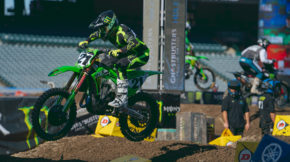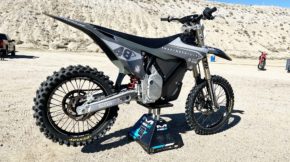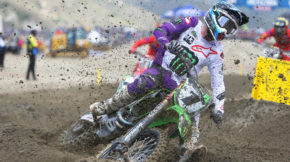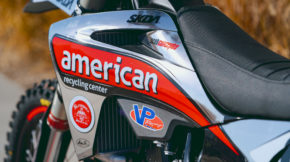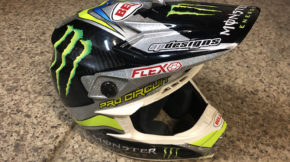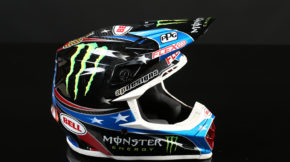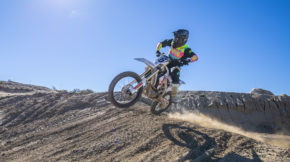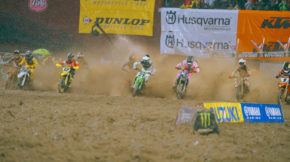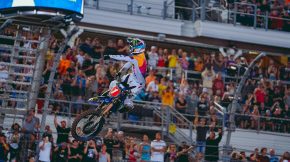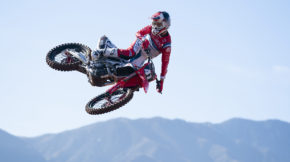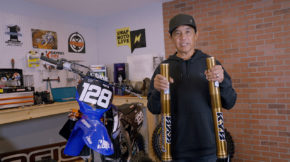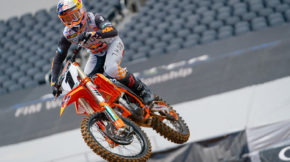2019 Swapmoto Live 250 Shootout
Share
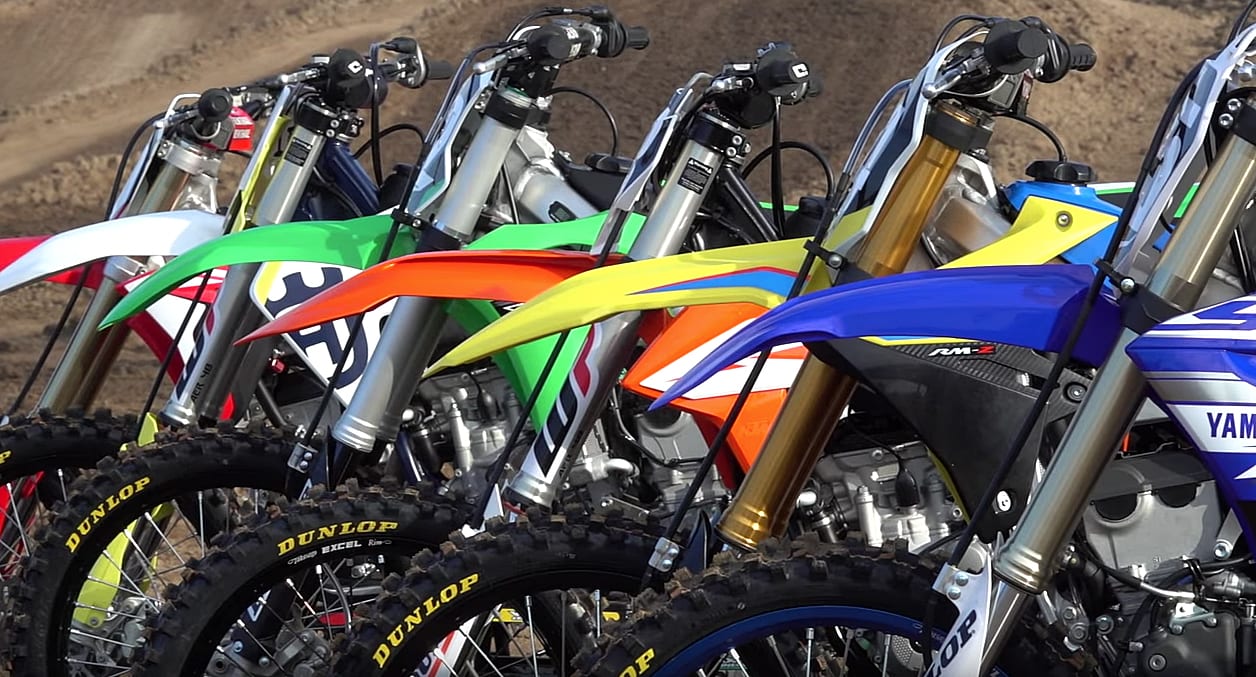
Honda CRF250R vs. Husqvarna FC 250 vs. Kawasaki KX250 vs. KTM 250 SX-F vs. Suzuki RM-Z250 vs. Yamaha YZ250F
By the Testing Staff of Swapmoto Live
Video by Casey Davis
It seems rather late to conduct a bike shootout, but with the all-new Suzuki RM-Z250 and revised Honda CRF250R only arriving on dealership floors in late November, waiting for the last two of the big six machines to arrive was a must. This year, we found ourselves in a unique situation as we had spent plenty of time on four of the bikes and had a good idea of how they stacked up against one another, but only needed to see where the yellow and red bikes fit in. 2019 is a great year to be a 250 rider, as all six bikes are competitive as delivered and each have shining points that make them uniquely desirable.
So what’s new? We’ll start with the most-changed motorcycles. The Yamaha YZ250F received a complete overhaul for 2019, with an all-new chassis, engine, and bodywork, following the pattern established one year prior by the YZ250F. Likewise for the Suzuki RM-Z250. Like last year’s RM-Z450, the new 250 from Suzuki has a new chassis and bodywork, and a revised powerplant that includes a new cylinder head and dual-injector throttle body. Kayaba spring forks and a matching shock are also a highlight. The KTM and Husqvarna, meanwhile, enjoy new chassis and engine settings. Revised EFI mapping for smoother power delivery and some revised suspension settings are the key talking points. Though it doesn’t look much different than last year’s bike, the 2019 Honda CRF250R boasts some significant internal engine changes that were incorporated for more low-end and mid-range power. Only the Kawasaki KX250 returns unchanged for 2019 – save for all-green radiator shrouds and new graphics – as a complete overhaul is expected for 2020.
With plenty of track days spent on most of the 2019 250s, we sent them back to the manufacturers for overhauls, wrapped all the wheels with Dunlop’s new MX33 soft-to-intermediate terrain tires, and converged on Perris Raceway for one final day of head-to-head comparison testing with six experienced test riders of varying age, speed, and ability. Ties were broken by two subsequent days of comparison testing, and though this year’s Swapmoto Live 250 Shootout results were as close as ever, there was a definitive favorite among the panel. Read on.
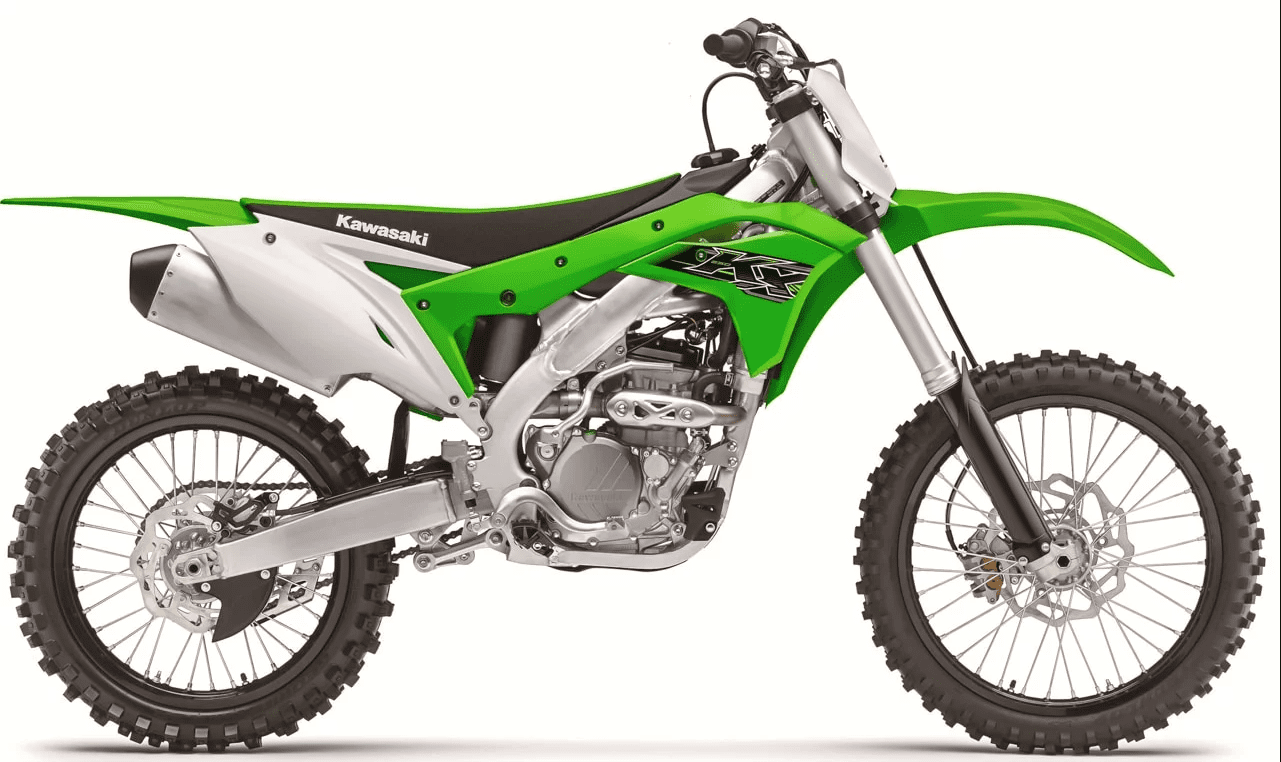
Sixth Place | Kawasaki KX250
Test Rider Scores: 6-5-5-6-5-6
Completely unchanged for 2019, the Kawasaki KX250 remains a great starting point for a potent race-bike build. In stock condition, it has a solid powerplant with very good power throughout the rpm range. It is not the most powerful in any portion of the powerband, but it is easy to ride and has a snappy feel. The Kawasaki has a small feel ergonomically, but thanks to the wide range of adjustments in footpeg and handlebar position, it can be made to fit taller riders, too. The Showa SFF spring fork is the bike’s weak point, as its performance left all testers unimpressed in fast, rough conditions with its disconnected feel. As evidenced by racing at the highest levels, the KX250 has a ton of hop-up potential and can be a race-winning machine.
Test Rider Hits
“I love the Kawasaki’s handling character as I can put it anywhere on the track. It definitely works better on tight tracks like Perris than fast circuits like Cahuilla.”- Curtis
“The KX250 doesn’t have any glaring weak points, it is strong and predictable throughout. It revs better than it chugs, and likes to be ridden hard.”- Foster
“The Kawasaki has nice bottom-end and mid-range, and if you grab the shifts at the right time it can be an effective engine.”- Garcia
“I really like the way the KX250 handles…in corners especially. The bike isn’t the fastest or most powerful, but it is right in the hunt.”- Maeda
“The Kawasaki powerband is very broad. It won’t rip you off the seat but the mapping is very good. I was pleased with the chassis and handling.”- Sleeter
“With the chassis being so narrow, it made it easy to grip with my legs. This made it also feel nimble and more controllable. Ergos are great for smaller guys like me.” – Whitsett
Test Rider Misses
“In faster sections the bike has a twitchy feel and I don’t like the performance of the forks. The engine flattens out on top compared to the others.” – Curtis
“Stability is hampered by a disconnected front end. Separate Function Forks are one of my least favorite designs and I’ll be glad to see it go.” – Foster
“The forks have a fidgety feel when hitting big bumps or landing hard and I never trusted the front end completely. The cockpit has an odd cramped feel.” – Garcia
“I was able to get the clutch to heat up easily. Mostly, I do not trust the front end of the bike. When I land hard, it feels as if the front end might deflect sideways.” – Maeda
“The fork blows through its stroke on the hard hits and was also nervous at high speeds. The muffler is loud and empty sounding. Raspy!” – Sleeter
“Power is not the best and I would consider it a mediocre powerband. The forks are hard to find a good setting for. Definitely my least favorite front end.” – Whitsett
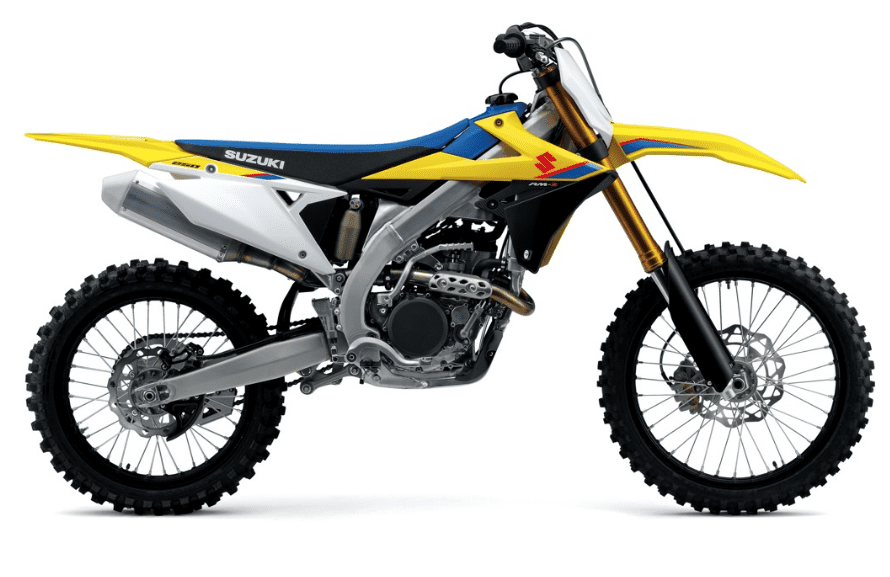
Fifth Place | Suzuki RM-Z250
Test Rider Scores: 5-6-6-5-6-5
The all-new RM-Z250 is a great bike with a ton of potential but as delivered, Suzuki really missed the mark with its suspension spring settings. Radically over-sprung, the Suzuki has a harsh ride for all but the heaviest and fastest riders. While overall balance is very good, the fork’s inability to settle hurts the bike’s cornering performance. With a softer setting, the bike carves like it always has and the Suzuki’s trademark razor-sharo handling remains intact. The new powerplant is much improved over years past and makes competitive power, but it is far from being the horsepower king of the class. The lack of electric start is disappointing, to say the least. Tied in points with the Kawasaki, we put the RM-Z fifth on the basis of its better – albeit incorrectly setup – suspension components.
Test Rider Hits
“What a huge improvement over last year! The power is a lot more aggressive and I love the way the bike handled once I went way out on the suspension clickers.”- Curtis
“The new RM-Z250 is a considerable improvement with a much more free-revving nature. The new ergos are sleek and the bike looks great.”- Foster
“The Suzuki has good bottom-end power and it is a lot more competitive than it used to be. As always, the bike’s strong point is its cornering abilities.” – Garcia
“I was surprised at how much better the new RM-Z250 performed and it’s actually a great option. It will require some work, but it is legit!” – Maeda
“This bike is a great foundation with good handling and stability. The suspension is very stiff and I would say that I could race it as it with some motor work.” – Sleeter
“The powerband is smooth throughout the rpm range and it is more powerful than it has ever been. The bike corners well and it is easy to throw into the ruts.” – Whitsett
Test Rider Misses
“The bike doesn’t have much top-end power, and it was hard to trust in the rough sections of the track because it was so rigid.”- Curtis
“Not only does it have a kickstarter; it’s also temperamental to start. The fork is harsh and busy, and has a disconnected feel from the track’s surface.” – Foster
“The suspension was way too stiff for me, but I think the chassis felt rigid as well. The engine falls flat on top and would need work to be competitive.” – Garcia
“I felt like I could jump off the Arc de Triomph with confidence. With some softer springs, the true nature of the bike would shine.” – Maeda
“A lack of power and overly stiff suspension are the weak points of an otherwise solid foundation. I feel cramped on the bike because the footpegs are so high.”- Sleeter
“The suspension is so stiff that it was impossible to set the shock sag for me. The engine needs works to race competitively and the lack of electric start stinks.” – Whitsett
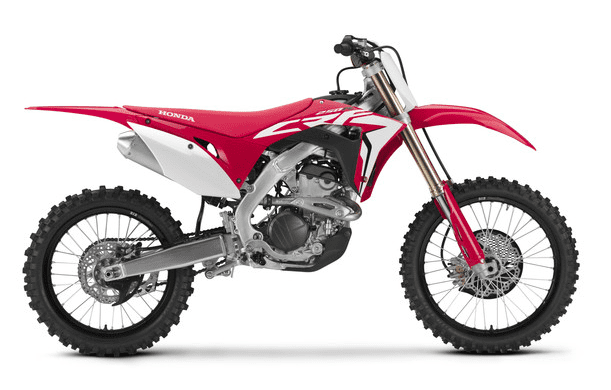
Fourth Place | Honda CRF250R
Test Rider Scores: 4-2-3-1-4-4
Test rider opinions varied widely regarding the Honda CRF250R. For 2019, the bike packs a bigger punch down low, but maintains its excellent mid-to-top-end pull. The bike is far from the fastest in the comparison, but it is amongst the best performing. Though it did gain torque down low, an even harder hit down low would benefit it greatly. The electric starter performs flawlessly, and the three EFI maps deliver markedly different performance. Ergonomically, the Honda is one of the most comfortable machines made, as its footpeg-to-seat-to-bars ratios are comfortable from riders of all heights. Suspension performance is excellent and well balanced, and the bike enjoys a high level of traction on both ends. One test rider, though, felt that the CRF suffered from a pitchy feel and did not trust the bike’s overall handling in stock condition.
Test Rider Hits
“Handling is this bike’s strong point. It corners like a dream and is extremely predictable through all the rough sections of the track.”- Curtis
“I’m claiming that the Honda is the best handling bike in the class. It certainly corners better than everything else with aggressive turn in and agile lean.”- Foster
“This is arguably the best handling bike. The suspension was valved very well for me. It felt plush, yet still firm enough. I could really push this bike.”- Garcia
“This bike handles amazingly well and I feel that I can put it anywhere on the track with minimal effort. I trusted it 100% within a couple corners.” – Maeda
“The power is mostly up top and it has a very good exhaust tone. When you are riding the bike high in the rpm range you are rewarded. Most comfortable ergos.” – Sleeter
“Probably the most comfortable bike and it was really fun to ride. It’s not the fastest but it was easy to go fast on this bike because it’s so easy to ride.” – Whitsett
Test Rider Misses
“You can tell that the bike has better low-end power than last year, but it still isn’t enough. You have to ride this bike hard to make it work great.” – Curtis
“Even in map three, the Honda would benefit from more low-end snap and torque. It requires diligent focus to keep the revs up to take full advantage of the power.” – Foster
“The Honda lacks low-end power and I learned that it was really important to stay in a low gear and rev the bike out to stay in the meat of the powerband.” – Garcia
“Map three is the most exciting. I wish there was a map four! If this bike had the power of the Yamaha, it would be the perfect all-around dirt bike, period.” – Maeda
“The balance of the bike was off for me. The rear overpowered the front and I felt that the bike lacked stability at speed under a load.” – Sleeter
“The bike sounds slower than it actually is. It often sounds like it is revving out, but it is still pulling. It took me a while to figure that out.” – Whitsett
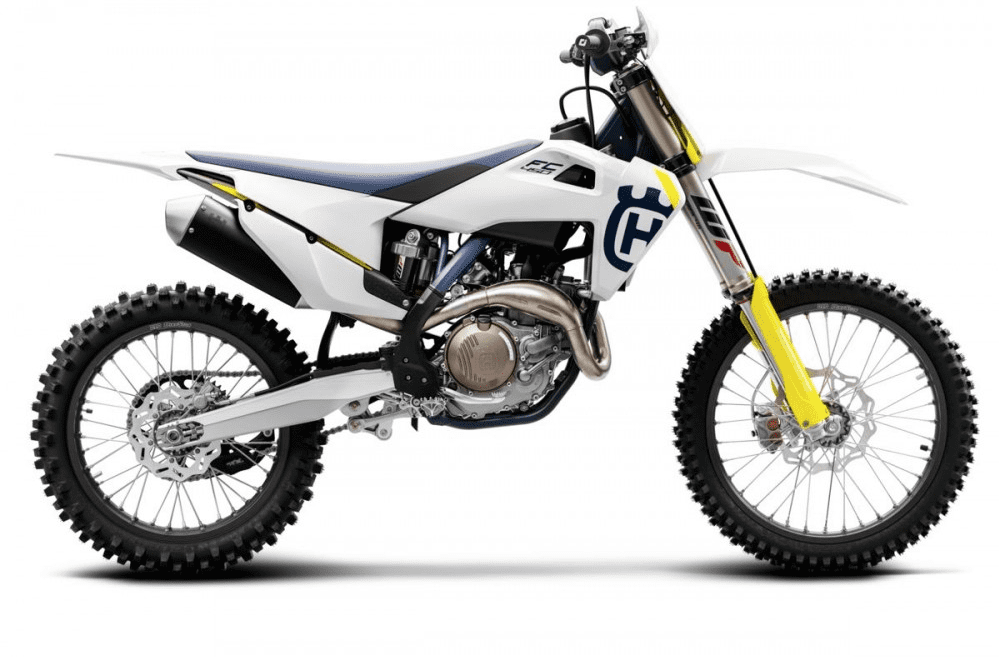
Third Place | Husqvarna FC 250
Test Rider Scores: 2-4-4-3-3-1
Last year’s 250 Shootout winner drops to third in the 2019 rankings, eclipsed this year by its Austrian brother, the KTM 250 SX-F. Though the attributes of the Husky that made it more popular than the KTM last year are still intact—better front-end feel and overall chassis comfort – the mapping changes made to both of the Austrian machines to provide a more linear powerband was more taxing on the FC 250 and its proprietary airbox and intake design. The FC 250 remains a very potent race weapon with a broad, linear spread of power and a very good suspension package and overall handling, but it was nudged out on overall power. Changes to the chassis affected some of the bike’s overall comfort, as greater rigidity came at the cost of some overall comfort.
Test Rider Hits:
“The Husky never seems to hit the rev limiter: it pulls forever! I love how well put together the rider cockpit feels. The Pro Taper bars are awesome.”- Curtis
“Long and broad power is the FC 250’s strong point, but I would like more snap down low. The overall handling is excellent with a blend of stability and agility.” – Foster
“The bike has a light and nimble feel and I love the controls that are all just right. The bike revs really far up top and that’s a plus.”- Garcia
“Love the smooth feel of the engine… it’s deceivingly powerful. The front end of the Husky feels better than the KTM, simply because of the Pro Taper bars.”- Maeda
“I love the chromoly chassis when it comes to predictability. Cornering is excellent as the bike dips into ruts with ease. Stability is phenomenal.”- Sleeter
“I like the feel of the WP air fork. I am a fan of how adjustable it is. It makes set up more complicated over a spring fork, but once you find the right setting it is great.” – Whitsett
Test Rider Misses:
“The AER48 air fork is a little harsh in the small chatter bumps and I don’t like having to check air pressure in my forks every time I ride.” – Curtis
“The AER48 is good for an air fork, however the new spring forks from the Japanese brands have taken a huge step ahead. The fork can be vague and imprecise.”- Foster
“The engine is very smooth a not very exciting. The front end dives too much entering corners and the fork has a vague feeling as far as traction goes.” – Garcia
“The steel frame feels flexy in some instances, as if it is “winding up” and getting ready to spit me off. The air forks lack control in small to mid sized bumps.” – Maeda
“The rear end lacks some comfort under acceleration. The engine needs to be ridden hard and kept in the high rpms because it lacks low-end power.” – Sleeter
“The bike’s weak point is a lack of low-end power, but I like to ride in the upper rpm so it’s not that big of a miss. The seat cover will wear holes in your pants.” – Whitsett
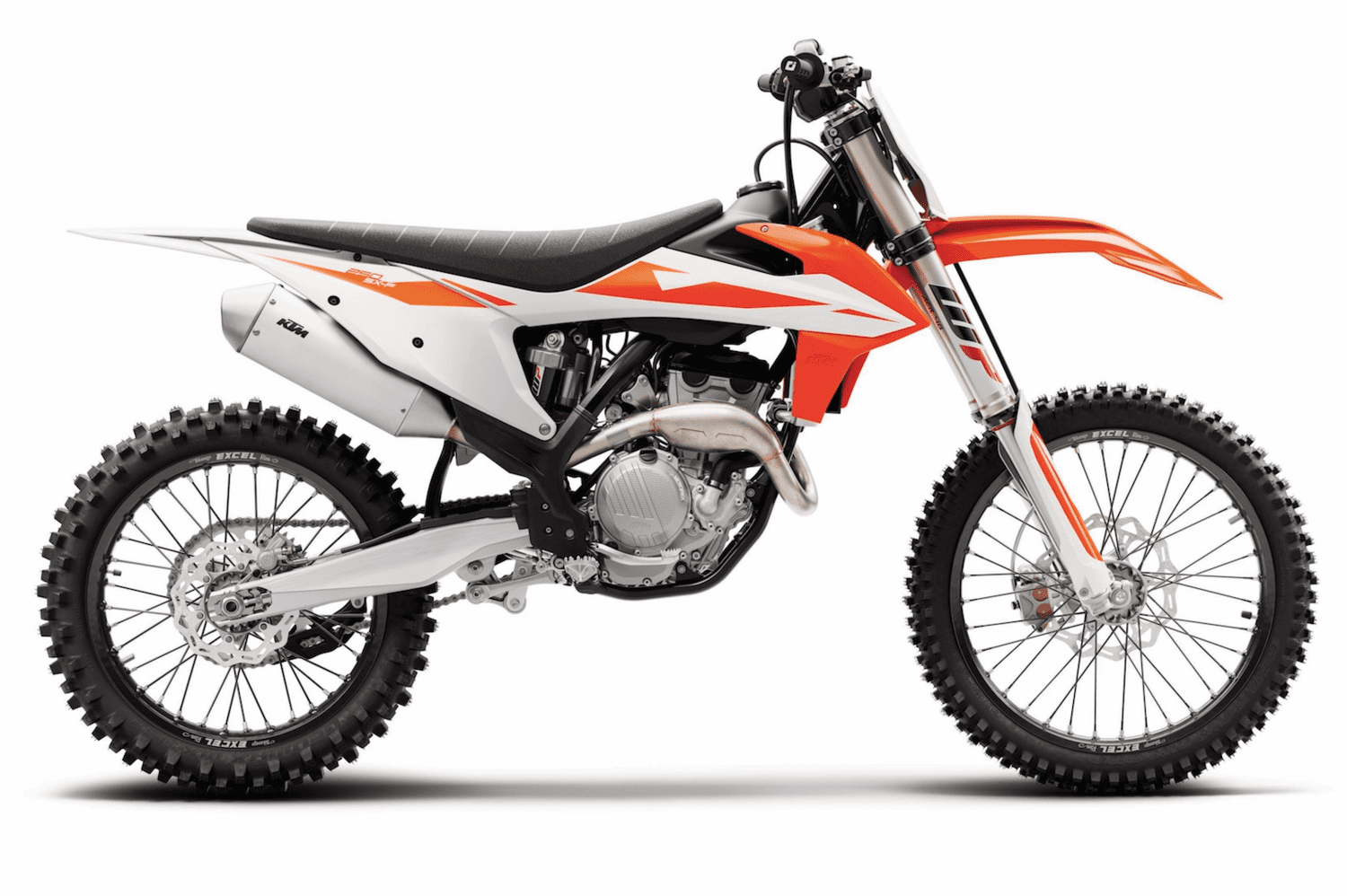
Second Place | KTM 250 SX-F
Test Rider Scores: 3-3-2-4-2-2
Like the Husqvarna, the KTM 250 SX-F received new EFI mapping that smoothed out the power curve and gave the bike a more linear powerband, as well as some chassis updates for added rigidity and precision. Test riders preferred the orange bike over the white this year because it was less affected by the new mapping, and the SX-F packs more low-end hit in addition to the excellent mid-range and top-end power. The orange machine corners beautifully, preferring to be leaned into a corner over being knifed in, and it exhibits confidence-inspiring traits everywhere else on the track. Straight-line, high-speed stability is excellent. Riders who are used to the steel frames of the Austrian machines loved the feel of the bikes, but the softer feel took getting used to for the others.
Test Rider Hits
“Handling is the bike’s strong point. The narrower chassis allows you to really lean the bike into corners. I really trust this bike entering and exiting corners.” – Curtis
“The KTM corners will without the front end ever feeling busy. It is eager to tip in to the corners and remains controllable throughout.” – Foster
“The engine revs to the moon and never stops building power. The KTM also handles really well and it feels light on the track and responds well to rider input.” – Garcia
“No one could ever argue with the quality of the components the Austrians utilize. From the Brembo brakes to the hydraulic clutch and quality parts’excellent.” – Maeda
“KTM’s power is very linear, and the top-end power is incredible. I am a rider who likes to rev the bike so it really suits my style.” – Sleeter
“The bike is super fast when you keep the rpms up… it never stops pulling! The bike corners really well and it is easy to throw into corners.” – Whitsett
Test Rider Misses
“The bike lacks some bottom-end grunt, and the front forks take some experimentation to find a good overall setting. The fork lacks comfort in rough sections.” – Curtis
“The suspension can feel soft and wallowy on decal, and I am not a huge fan of the air fork. I’d prefer more snap out of the engine down low.” – Foster
“I am not a fan of the WP AER48 air fork. It gives the bike an unstable feel in rough braking bumps and it dives through the stroke entering corners.” – Garcia
“When other bikes had air forks I praised the AER48 as the best air option. Now that they are the only air fork left, I don’t like them as they lack control and feel.” – Maeda
“The AER48 is the weak link. The performance is good, but they build pressure as you ride so you have to account for and monitor that.” – Sleeter
“I don’t like the handlebars because they have and odd bend and they are more rigid than the Husky bars. More rigidity equals less comfort.” – Whitsett
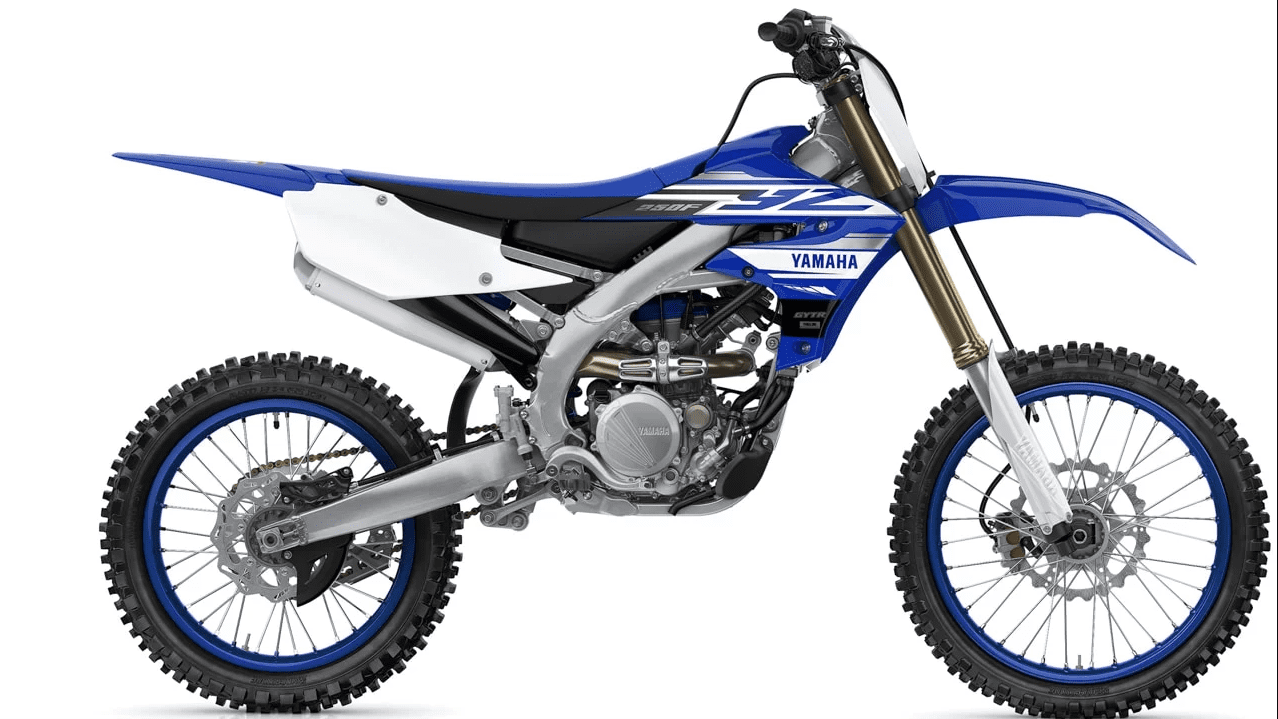
First Place | Yamaha YZ250F
Test Rider Scores: 1-1-1-2-1-3
All-new for 2019, the Yamaha YZ250F is a machine without rival when it comes to being the complete package. With the hands-down most effective powerplant in the class, the Yamaha produces more low-end power and response than any of its competitors, and pulls strong and hard through the middle and up top. The YZ250F’s Kayaba suspension drew rave reviews from every test rider, and the fork is regarded by all to be the best in class with a high degree of comfort, control, and bottoming resistance. The new chassis is narrower than the previous generation and the bike does not suffer from the vague cornering characteristics of the past. The blue bike drew rave reviews from all six test riders. There is no denying the 2019 Yamaha YZ250F as the Swapmoto Live Bike of the Year.
Test Rider Hits
“Power is incredible and without fault. The suspension is best in class and the bike inspires confidence everywhere. The rougher the better when you’re on blue.” – Curtis
“The YZ250F’s suspension is similar to it’s engine: it sets the standard high for everyone else to aspire to. The YZ250F does not have a weak point.” – Foster
“The YZ250F has the best bottom end and torque of all the bikes and I could ride it in a gear higher everywhere. The suspension is the best in class, too.” – Garcia
“As if the engine wasn’t good enough, Yamaha’s Power Tuner app renders many aftermarket parts obsolete. This is the ideal powerband, period.” – Maeda
“The new chassis corners very well and the KYB hit the mark completely. The engine has a tremendous amount of torque and it still revs to the moon.” – Sleeter
“So powerful! Even if I made a mistake I was able to clutch it and still clear the jumps. Well balanced and easy to trust in the roughest parts of the track.” – Whitsett
Test Rider Misses
“If I bought a Yamaha I would ride with earplugs because it is so loud. I would also change the stock handlebars or get the higher mounts.” – Curtis
“The YZ250F corners better than average and that is it’s only weakness… that it doesn’t corner as amazingly as it does all else.” – Foster
“The bike feels wide in corners and that is its only downfall. I would change the stock bars right away, too.” – Garcia
“The only downfalls of the Yamaha YZ250F for me, are the awkward bend of the stock handlebars and the slightly wide feel of the bike at the radiators.” – Maeda
“I really wish the bike didn’t sound like it does, but that is the only complain that I can come up with. I am very impressed!” – Sleeter
“Though the bike is narrower, it still feels wide for me and that makes it harder to lean into corners with. I hate the way it sounds with the airbox up front.” – Whitsett
Rider Impressions
Chase Curtis
19 yrs./5’11”/170 lbs./Novice
1. Yamaha YZ250F
2. Husqvarna FC 250
3. KTM 250 SX-F
4. Honda CRF250R
5. Suzuki RM-Z250
6. Kawasaki KX250
With five of the six bikes receiving major changes, this was a hard decision. Yamaha came out on top for me simply because of how strong the bike is all around. Great power and suspension! The next three were super close: the Husky with a smooth powerband and comfortable chassis, the KTM with a slightly stronger powerband but harsher chassis, and the Honda with an amazing chassis and suspension but a softer engine. I could ride all of them with a smile. If the Suzuki were not so stiff it would have been up there with the others, but we’re rating them stock. As the only unchanged bike, the Kawasaki is a great bike but a little uninspiring for me.
Pat Foster
41 yrs./6’1”/185 lbs./Pro
1. Yamaha YZ250F
2. Honda CRF250R
3. KTM 250 SX-F
4. Husqvarna FC 250
5. Kawasaki KX250
6. Suzuki RM-Z250
The Yamaha is the clear winner for me because it encompasses an amazing overall package with no shortcomings. The YZ250F powerplant is the best in class and the suspension is too…an easy winner for me. The Honda is a very close second with arguably the best chassis I have ever ridden. This bike is so much fun! It feels light, corners amazingly well, yet stays stable in the straights. The engine loves to be revved and rewards an aggressive riding style. For pure fun, the Honda wins! The KTM and Husky are close and are both fantastic packages. I just wish they had more down low. The Kawasaki and Suzuki are also close, but the miss on Suzuki’s suspension gave the nod to yellow.
Rene Garcia
18 yrs./5’9”/145 lbs./Pro
1. Yamaha YZ250F
2. KTM 250 SX-F
3. Honda CRF250R
4. Husqvarna FC 250
5. Kawasaki KX250
6. Suzuki RM-Z250
At the end of the day I feel the Yamaha is the best and most well rounded bike out there. The engine leads the class by a respectable margin. The KTM is an awesome bike with a smooth power curve that revs to the moon and WP air fork is the only thing holding the SX-F back. The Honda handles great, and the suspension is very good; it only lacks some low-end torque. I put the Honda between the KTM and Husky because the FC 250 lacks more bottom end than the KTM. The Kawasaki and Suzuki are both great bikes but I would need to work on them before I could race either of them competitively.
Donn Maeda
50 yrs./5’9”/175 lbs./Intermediate
1. Honda CRF250R
2. Yamaha YZ250F
3. Husqvarna FC 250
4. KTM 250 SX-F
5. Suzuki RM-Z250
6. Kawasaki KX250
I ride 250s for fun, and when it comes to fun there is no beating the Honda CRF250R. though it doesn’t have the power of the Yamaha YZ250F, the red bike handles like a dream and allows me to ride more aggressively than I can on any of the other machines. The bike corners great and inspires confidence. The YZ250F is the best race bike in class and it is potent in stock condition. If only it were a tiny bit narrower! The Austrian bikes are both solid, but their frame flex occasionally catches me off guard. I really like both the Kawasaki and Suzuki, but I see more potential in the Suzuki suspension as I dislike the SFF design.
Mike Sleeter
38 yrs./5’8”/165 lbs./Pro
1. Yamaha YZ250F
2. KTM 250 SX-F
3. Husqvarna FC 250
4. Honda CRF250R
5. Kawasaki KX250
6. Suzuki RM-Z250
The Yamaha’s engine is a beast! You can never have too much power in the 250 class and Yamaha leads the way. The chassis complements the engine and as a package the YZ250F is unbeatable. The KTM and Husky are great, too, but the WP AER48 air fork and slightly softer powerbands are why these bikes round out the podium. The Honda was tough for me because my riding style doesn’t quite match up with the chassis. The front end got really deep under braking and the back end would kick. The Kawasaki and Suzuki leave me wanting more! No electric start and manual couplers to change the mapping? Come on, this is 2019…
Cody Whitsett
21 yrs./5’8”/130 lbs./Intermediate
1. Husqvarna FC 250
2. KTM 250 SX-F
3. Yamaha YZ250F
4. Honda CRF250R
5. Suzuki RM-Z250
6. Kawasaki KX250
I liked all six bikes this year but my favorite was the Husqvarna. The Husky has a slight edge over the KTM because it seems to rev freer than the KTM. Both bikes are fast, light, and easy to ride, but I am simply more comfortable on the white bike. The Yamaha gave the European bikes great competition this year with the best engine and suspension, but it was harder for me to corner on because it is so wide. The Honda is a great bike all around and it handles awesome, but it is lacking in the engine department. The Suzuki and Kawasaki both lack electric start and are just not as quick as the others. They have potential though!










